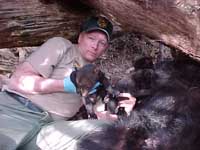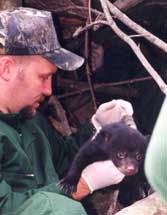.gif)
.gif) |
 |
|
 |
 |
| Hunting Home | Contact Us | News | DNR Home |  |
|
|
| Wildlife Diversity |
| Fishing |
| Law Enforcement |
| Publications |
| Disability Services |
| News/Info |
| Licensing |
| go Wild! |
| License Plate |
| Kid Zone |
Black Bear Monitoring and Research StudyThe black bear monitoring and research project was initiated in 1999 to gather demographic information from bears in Boone, Fayette, Kanawha, and Raleigh counties and to learn more about bears captured as a result of nuisance behavior. Bear seasons have been and will continue to be modified based primarily on data collected through this study. A northern study area primarily centered in Randolph and Tucker counties was added in 2004 to reexamine demographic parameters of the bear population from data previously collected in the 1970s and 1980s. One of the primary goals of this project is to identify the best cost effective way for the DNR to effectively manage the bear population. Wildlife managers did an incredible job in both study areas of trapping bears in 2006. Wildlife managers have handled 579 adult bears 1,118 times on the southern study area since 1999. Bears handled during nuisance complaints were given orange ear tags so that they could be easily identified; whereas, bears caught specifically on research trap lines for the purpose of marking additional bears were tagged with black ear tags. Wildlife managers handled 31 newborn cubs (18M; 10F; 3U) in 11 litters ( In the southern study area, 129 (59M: 70 F) bears were tagged in 2006 or were still wearing their radio transmitters from previous years. One hundred six (40M: 66F) of the 129 bears were in the 4-county study area and considered available for harvest. Most of the additional bears outside of the study area were trapped and relocated as part of normal DNR activities. Age data was not available at press time; however, it is estimated that there were 6 yearlings and 60 2+ year-olds in the female sample within the study area. Thirty-eight females were equipped with working radio transmitters at the start of the 2006 hunting season. Six of 66 (9%) females and 4 of 40 males (10%) available for direct harvest in the southern study area were reported dead during the 2006 hunting season. Two (2M: 0F) bears were harvested during the bow season, 7 (2M: 5F) during the early November season, and 1 (0M: 1F) during the buck gun season. There were 26 known deaths of tagged bears during the 2006 hunting season in the southern study area. These known deaths were a combination of bears tagged during the entire study period that have not been previously reported. Sixteen (9M: 7F) bears were harvested during the early November dog season, 5 (4M: 1F) during the bow season, 1 female during the buck gun season, 1 male during the December season, 1 male was killed illegally, and 2 (1M: 1F) were harvested but the hunter did not state specifically what season. Wildlife managers in Districts 1 and 3 marked 85 (39M: 46F) bears during 2006 to gather demographic data on the bear population in our traditional counties. Seventy-six bears (32M: 44F) were available for harvest inside the study area. Thirty-four female bears were equipped with radio transmitters at the start of hunting season. Two (5%) females and 14 (44%) males available for direct harvest died after October 1. Four (4M: 0F) were harvested by archery hunters, 11 (10M: 1F) were harvested in December, and 1 female died from a vehicle collision. In addition to the 16 known deaths from bears handled in 2006, 4 (3M: 1F) bears handled before 2006 died during archery season and 4 (3M: 1 F) bears handled before 2006 were harvested during the December firearms season. On the northern study area wildlife managers worked 9 dens with 23 (10M: 13F) newborn cubs ( In addition to the population monitoring and research project, the DNR has cooperated in a project at Virginia Tech to evaluate the accuracy and effectiveness of reconstructing black bear and white-tailed deer populations from age data. Currently the project is in its final stages and manuscripts have been submitted for publications. In summary, the project demonstrated that Downing age reconstruction is a very effective method of estimating bear populations if a random or complete sample is taken from the harvested population. The West Virginia Black Bear Monitoring and Research Project graciously accepted 5 donations from private groups during 2006. The West Virginia Outdoor Sportsman, the West Virginia Trophy Hunters Association, and 3 anonymous donations by the same person have all provided funds to help us buy additional radio transmitters. Their support of our natural resources and projects help to demonstrate the cooperation between the WVDNR and multiple groups. We thank them for their continued support. |
 |
 |
|
 |
|
HOT TOPICS... |
|||||||
|---|---|---|---|---|---|---|---|
|
Trout Stocking |
Wildlife Viewing |
Licenses/Permits |
| Fishing Waters | Park Regulations | |
|||||||
|
Contact Webmaster
|
dnr.wildlife@wv.gov © West Virginia Division of Natural Resources |
|||||||